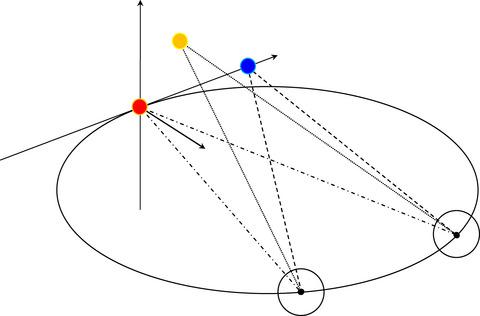当前位置:
X-MOL 学术
›
Eur. J. Nerosci.
›
论文详情
Our official English website, www.x-mol.net, welcomes your feedback! (Note: you will need to create a separate account there.)
Measuring vergence and fixation disparity in 3D space
European Journal of Neroscience ( IF 3.4 ) Pub Date : 2020-08-03 , DOI: 10.1111/ejn.14929 Jean Duchesne 1 , Olivier A Coubard 2
European Journal of Neroscience ( IF 3.4 ) Pub Date : 2020-08-03 , DOI: 10.1111/ejn.14929 Jean Duchesne 1 , Olivier A Coubard 2
Affiliation

|
As the eyes continuously move in 3D space, they rarely converge at the exact depth of the plane even when fixating a 2D image or computer screen. Rather, the lines of gaze measured by eye movement recordings show some misalignment so‐called fixation disparity. Fixation disparity occurs in front of or behind the plane, and the eyes may also be lagged vertically. For those reasons, vision research requires mathematical tools to calculate where exactly the lines of gaze cross the stimulus plane. Seminal research on vergence eye movements targeting stimuli lying on isovergence curves has been content with simple computation of the difference between the two eye rotation angles. Recently, the need of new calculations has emerged with the increasing use of eye‐trackers providing the eye coordinates on a computer screen. Previous studies have made this attempt but with restrictions. We introduce here a complete calculation of fixation disparity in 3D space allowing vision researchers to study the precision of gaze regardless of the stimulus location in 3D space and of whether the eyes lag horizontally and/or vertically.
中文翻译:

测量3D空间中的聚散度和注视差异
由于眼睛在3D空间中连续移动,即使固定2D图像或计算机屏幕,它们也很少会收敛于平面的确切深度。相反,通过眼动记录测量的凝视线显示出一些未对准的现象,即所谓的注视差异。固定视差发生在平面的前面或后面,并且眼睛也可能垂直滞后。由于这些原因,视觉研究需要数学工具来计算凝视线准确地穿过刺激平面的位置。对以等速曲线为基础的刺激进行的收敛眼运动的开创性研究已经满足于简单计算两个眼旋转角之间的差异。最近,随着越来越多地使用在计算机屏幕上提供眼睛坐标的眼动仪的出现,对新计算的需求不断增加。先前的研究已经进行了这种尝试,但是有局限性。我们在此介绍了3D空间中注视差异的完整计算,使视觉研究人员可以研究注视的精度,而无需考虑3D空间中的刺激位置以及眼睛是否水平和/或垂直地滞后。
更新日期:2020-08-03
中文翻译:

测量3D空间中的聚散度和注视差异
由于眼睛在3D空间中连续移动,即使固定2D图像或计算机屏幕,它们也很少会收敛于平面的确切深度。相反,通过眼动记录测量的凝视线显示出一些未对准的现象,即所谓的注视差异。固定视差发生在平面的前面或后面,并且眼睛也可能垂直滞后。由于这些原因,视觉研究需要数学工具来计算凝视线准确地穿过刺激平面的位置。对以等速曲线为基础的刺激进行的收敛眼运动的开创性研究已经满足于简单计算两个眼旋转角之间的差异。最近,随着越来越多地使用在计算机屏幕上提供眼睛坐标的眼动仪的出现,对新计算的需求不断增加。先前的研究已经进行了这种尝试,但是有局限性。我们在此介绍了3D空间中注视差异的完整计算,使视觉研究人员可以研究注视的精度,而无需考虑3D空间中的刺激位置以及眼睛是否水平和/或垂直地滞后。

























 京公网安备 11010802027423号
京公网安备 11010802027423号